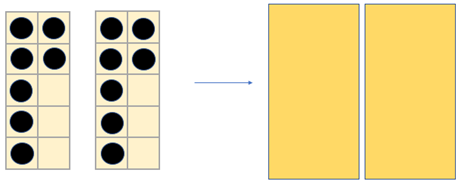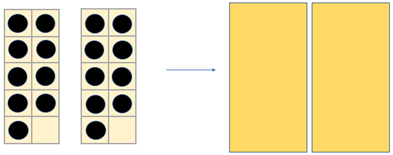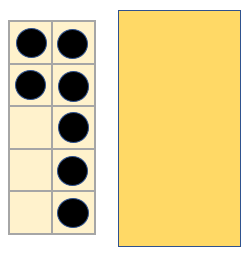Purpose
The purpose of this activity is to support students learning and applying their doubles addition facts to 20.
Achievement Objectives
NA2-3: Know the basic addition and subtraction facts.
Required Resource Materials
- Counters (circular, square or novelty counters)
- Blank tens frames (use page 2 of Material Master 4-6)
- Masking card (A5 size is good)
Activity
- Pose addition problems with doubles to 20 by showing a collection of counters across 2 tens, and then masking both collections. For example:

I have seven counters here and seven counters here. How many counters are there altogether?
How do you know there are 14 counters?
- Provide time for students to share their thinking in pairs or small groups, and then with the wider class.
Highlight that derived strategies that use part-whole thinking are more efficient than those that are counting based. For example, “I know 5 + 5 = 10 and I know 7 + 7 is 4 more.” If needed, encourage students to use the unmasked tens frames to justify their thinking. For example:
There are 6 counters missing across the two tens frames. How does this help you figure out the total number of counters?
What other patterns can you see in the tens frames (e.g. 2 columns of 5 and 2 columns of 2).
- Record the equation for the double fact, e.g. 7 + 17 = 14.
- Ask: If you know 7 + 7 = 14, what other facts can you know?
Make a list of the related facts that students suggest, including subtraction facts. For example:
6 + 7 = 13
7 + 6 = 13
8 + 7 = 15
7 + 8 = 15
14 – 7 = 7
14 – 8 = 6
If needed, you, or pairs of students, could Illustrate each derivation from 7 + 7 = 14 using the counters and tens frames.
- Repeat this process - modelling a doubles equation using counters and tens frames, masking the equation, asking for the sum, recording the equation, and making a list of derived addition and subtraction facts - with other doubles facts to 20. For example, 9 + 9 could be explored as follows:

How do you know 9 + 9 = 18?
Students might notice that the answer is 2 less than 20 or that it is equivalent to10 + 8.
How do you know that 9 + 9 is 2 less than 20?
How do you know that 9 + 9 equal to 10 + 8?
Record the known fact, 9 + 9 = 18
- Ask for related basic facts, for example:
If 9 + 9 = 18, what is 8 + 9?
If 9 + 9 = 18, what is 9 + 7?
Use the counters and tens frames to provide additional visual support and emphasise how the 2 facts are connected.
Next steps
Patterning supports students to connect the addition facts which aids memory. Patterning also supports connections to subtraction.
- Set up addend unknown facts using tens frames. For example:

There are 14 counters altogether. How many counters are hidden?
Record 7 + __ = 14 and establish the missing addend is seven using doubles fact knowledge.
- Ask students to use the 7 + 7 = 14 fact to solve these problems:
7 + __ = 13 7 + __ = 15 6 + __ = 14 8 + __ = 14
The answers students give can be confirmed by adding or subtracting counters from the frame model. As much as possible, encourage students to rely on symbols and knowledge, rather than using counters.
- Provide lots of opportunity for practice and provide students with a way to monitor their progress in learning the facts. Ensure students have opportunities to express their mathematical thinking in different ways (e.g. online tasks, written, verbal, drawn diagrams, acting out, using physical manipulatives). Double Somersaults Plus or Minus One game (Material Master 4-33) might be used.
Add to plan
Level Two